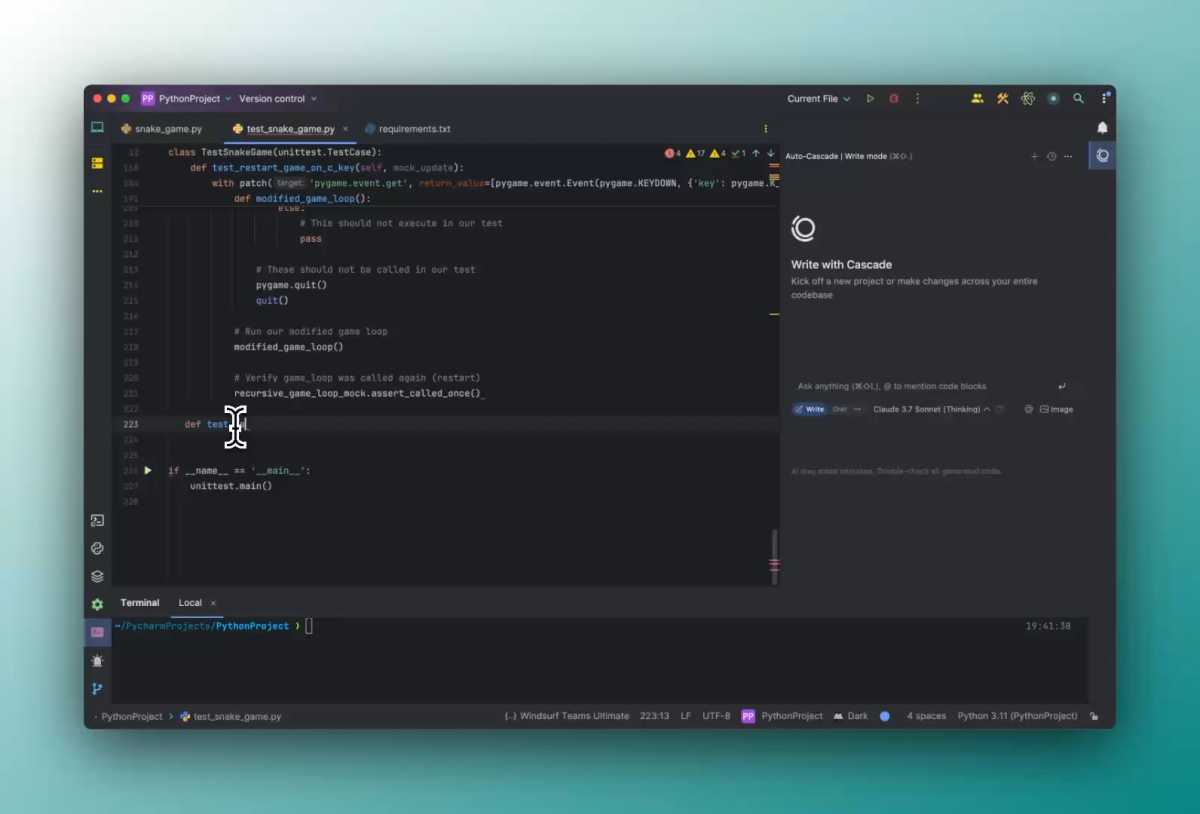Vibe coding with AI is easy! 7 tools, tips, and tricks to get started
Vibe coding is programming by gut feel. You have an idea for a tool, a website, or a repetitive task you want to automate… but instead of enrolling in a coding boot camp or slogging through YouTube tutorials, you fire up an AI chatbot and have it write the code for you.
This AI-driven approach to creative coding has exploded in popularity over the past year or two—chiefly because it works. People are building genuinely useful stuff without even knowing what a variable is. I’ve been vibe coding my own apps with AI and I’m absolutely loving it, despite being a relative newbie to coding.
But most advice about AI-assisted programming still assumes you want to become a “real” programmer eventually. Because of that, the advice tends to steer you towards professional tools that are overkill for simple projects. You need a different—easier—approach.
PROMOTION
Launch in minutes by vibe coding
Turn your ideas into reality with Hostinger Horizons. Build web apps, websites, and custom tools by chatting with the AI – no coding required. Get everything you need to launch and grow including web hosting, domain management and email.
Here’s what you really need to start vibe coding your own stuff right now, without any of the BS that only complicates matters.
Table of Contents
Use an AI chatbot, not an AI-assisted IDE
Your first instinct might be to use an AI-assisted integrated development environment (IDE), one that you’ve heard is good for vibe coding, like Windsurf, Cursor, or even Claude Code (which technically isn’t an IDE, but that’s besides the point). All of these tools are built for AI coding, so they’re the best place to start, right?
Well… no. These tools are designed to make highly productive programmers even more productive, and that means they assume a level of knowledge that amateur coders—like you and me—lack. Diving into these programs straight away is likely to leave you confused and discouraged.

Windsurf
Not to mention that AI-powered IDEs are pretty darn expensive, too. While most offer a bit of free use, it’s easy for even uber-casual vibe coders to find themselves in need of a paid plan. Many such IDEs charge based on usage instead of a flat monthly rate, too.
As an amateur vibe coder, you’re better off using an AI chatbot. The downside here is that you’ll need to copy-paste code back and forth between the chatbot and your code editor. It’s a bit of a nuisance, but it’s not too bad if your project is small.
Choose your AI chatbot carefully
When it comes to AI chatbots with programming proficiency, there are several you can choose from. All of the popular ones are good enough to get started, but even so, I have a couple recommendations.
Don’t want to spend a dime? Try Google’s AI Studio. This chronically under-appreciated AI tool provides free and effectively unlimited access to Google’s latest Gemini Pro models, which many consider the best in the business without paying a cent.
Google AI Studio does have a few downsides. Google will train on your data (most paid services promise they don’t), the interface isn’t the best, and there’s no desktop or mobile version. None of these are serious obstacles for amateur vibe coding, though.

Matt Smith / Foundry
But if you’re willing to pay a bit and want an attractive interface with desktop and mobile apps, I recommend Anthropic’s Claude Opus.
I like Claude’s Artifacts feature, which breaks code out in a separate interface pane. It can even execute some code (like HTML or JavaScript) to provide a preview in Claude itself, and you can download code to your PC from this pane. Competitors have emulated it with similar features, but I think Anthropic’s implementation remains the best.
Stick to popular programming languages
Choosing a programming language is a major obstacle for both amateur and experienced programmers. There are hundreds to choose from, dozens of them are mature, and promoters of each tend to have strong opinions, so it’s easy to fall into analysis paralysis.
When it comes to vibe coding, though, I recommend that you stick with languages that are both popular and forgiving. That means the usual suspects of JavaScript/TypeScript, Python, HTML, and perhaps C# if you’re feeling saucy. AI does best with these languages because AI models are trained on data from across the web. The more popular the language, the more examples there are to train on—and the more source data to work with, the better the generative results.
As for how forgiving a particular language is, it’s an important aspect to consider because you’ll be quicker to get a program up and running even when it has bugs. Some languages, like Rust and C++, have strict syntax and architectural demands that can be a nightmare to debug.
Veteran coders are likely to recoil at the idea of willingly accepting bugs in a program, but for beginners, it’s better to have a buggy-yet-functional program than a program that was abandoned because it never worked.
Alternatively, you could let the AI choose your language for you. Describe the program you want to create and ask the chatbot to make it in whatever language seems most appropriate.
Choose a simple code editor
Once you have a chatbot and coding language picked, you’ll need to choose the software you use to edit code.
You may feel pushed towards a full-blown programming IDE like Visual Studio, which is admittedly powerful but, again, designed for people who have some knowledge of programming. For casual vibe coding, I recommend a simpler code editor like Notepad++, Sublime Text, or UltraEdit. (My bias is towards Notepad++.)

Matt Smith / Foundry
Code editors lack the comprehensive terminal, debugging, and remote development features found in many IDEs. However, code editors still provide a fast, functional, and approachable interface that looks more like the barebones text editors you’ve likely used (e.g., Notepad), and they still provide handy features like code auto-completion.
Think small (and reinvent the wheel)
Scope creep is a common problem that all programmers face, and it can stop you cold. Big projects are more difficult than small projects, and vibe coding grows more difficult as the size of a project increases.
So while it might be tempting to try vibe coding your way to a full-blown 3D game or world-class accounting software, you might want to hold your horses and start small. Very small.

Matt Smith / Foundry
Here are some great entry-level project examples for vibe coding:
- Python scripts that automate specific tasks, like scraping web pages for data or filtering documents by various criteria.
- A single-page personal website or app in HTML and JavaScript.
- A single-feature app programmed in Python or C#.
My first vibe-coded project was a dice-rolling tool with text-to-speech capability for the tabletop strategy game Battletech. It can roll dice and announce the results of a roll, speeding up play. I also vibe-coded my own personal website, a single page of HTML with some JavaScript.
Use AI to troubleshoot issues, answer questions, and generate documentation
You might be surprised by how quickly AI can help you vibe code basic tools and programs. It’s so easy to pop out a quick Python script, you may find yourself doing it several times a day at one point.
However, heavy reliance on vibe-coded projects can lead to another problem: losing track of how each script and program works, and becoming confused by dependencies.
For example, Python programs typically don’t work right out of the box. You’ll need to install Python as well as the various libraries that are used to accomplish different things in a script. Not only do you have to figure that out, but if you ever move to another computer, you’ll also have to set up Python and those dependencies on that computer as well.
Fortunately, AI is great at solving this problem. Just ask and it’ll provide you with instructions on how to install a new programming language and any related libraries on your computer. This will typically involve a handful of command-line prompts.
I also recommend ending every vibe coding session by asking the AI to create documentation that teaches new users how to use the generated program. And when you use AI to modify existing scripts or programs, it’s a good idea to ask for a changelog of everything it does. Documentation will help you remember how your program works and help you get it working when you switch computers.
Pick up Arduino and/or Raspberry Pi
Python scripts and web pages can be useful, but they lack pizzazz… and that can be discouraging for any new vibe coder. If you want to try programming something that feels more tangible and exciting, then I recommend picking up an Arduino and/or Raspberry Pi.
Going this route is likely to increase your starting costs and will make your vibe coding journey more complicated. You’ll need to buy some hardware and most likely a soldering iron. You’re also going to need to pick up some skills that AI can’t help with, like soldering.

Raspberry Pi
While you can use AI to suggest Arduino and/or Raspberry Pi projects, I recommend picking a tutorial that already exists, like this Raspberry Pi Pico W weather station by ExplainingComputers. The tutorial explains the basics, of course, but the AI chatbot can further explain concepts that you don’t quite understand and handle edge cases.
For example, I had a different temperature sensor than the one in the tutorial, so I had to wire it differently than how it was shown and make changes to the code to identify my sensor. With the help of AI, I was able to make the required changes in just 15 minutes.
Further reading: Practical Raspberry Pi projects anyone can do
PROMOTION
Launch in minutes by vibe coding
Turn your ideas into reality with Hostinger Horizons. Build web apps, websites, and custom tools by chatting with the AI – no coding required. Get everything you need to launch and grow including web hosting, domain management and email.






